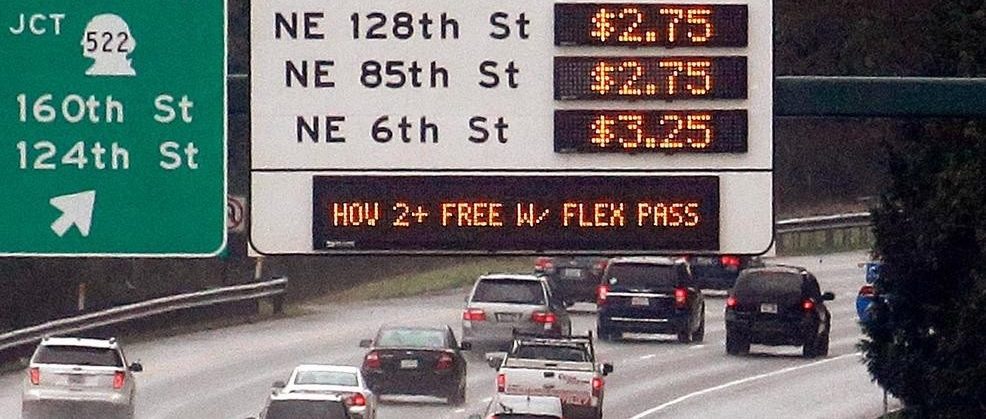Project lead: Mark Hallenbeck, Director, Washington State Transportation Center, University of Washington
Data science lead: Vaughn Iverson
DSSG fellows: Shirley Leung, Cory McCartan, Christopher (CJ) Robinson, Kiana Roshan Zamir
Project Summary: Traffic congestion is a worldwide issue with environmental, health, and economic impacts. We cannot build our way out of it. Funding is limited and land for building new roads is finite. Building bigger roads in urban areas simply leads to more traffic and more congestion. Therefore, transportation authorities need new ways to optimize the performance of existing and future roadways. Many regions like the Puget Sound are exploring a variety of congestion pricing schemes to both generate revenue for roadway system improvements and to more sensibly manage traffic flow.
The Washington State Department of Transportation has partnered with the DSSG program to better understand travel behavior on I-405’s congestion priced Express Lanes. The DSSG team is examining: the time savings achieved by I-405 Express Lanes users; how those time savings vary given facility price; and how socio-demographic, geographic, and mode choice factors affect how the benefits and costs of the Express Lanes are distributed. Finally, DSSG will also examine how user behavior affects roadway performance. The intent is to provide WSDOT with important information needed to understand the effectiveness of current congestion pricing policies and guide future pricing policy decisions.

Project Outcomes:
Who uses the HOT lanes? The team estimates that the median household income of noncommercial HOT lane users is approximately $101,000 per year, around 20% higher than the median household income of King and Snohomish counties. Fifteen trips are made for every 1,000 households in the region making $50,000 per year, while 35 trips are made for every 1,000 households making $200,000 per year, a 133% increase. Yet most facility trips are not made by high-income households. The team estimates that over 80% of facility users have an income below $200,000 per year.
Who benefits from the HOT lanes? Higher-income households accrue far more net benefit than lower-income households do. The average $200,000-per-year household in the region gains around 6.5 cents in net benefit from the facility, 86% higher than the 3.5 cents gained by the average household making $50,000 per year. This pattern is almost to be expected, however, given the income differential in usage. Households which use the facility more often naturally accrue more benefits. In fact, the same $200,000-per-year household which takes in 86% more benefits than a $50,000-per-year household uses the facility 133% more. This discrepancy becomes much more visible when net benefits are considered on a per-trip basis.
Who benefits per trip? The equity picture looks much different per trip. Lower-income households actually gain more net benefit per trip than do higher-income households. Returning to the same hypothetical households above, at $200,000 and $50,000, the former gains 21% less in net benefit per trip than the latter does. Overall, however, the distribution is quite even: nearly all drivers can expect a per-trip net benefit between $1.50 and $2.50. Of course, there is substantial variation in net benefit across specific trips; the findings presented here are merely averages across a large number of users and trips.
Learn more and view supporting graphs and final presentation slides on the project website. View a video of all four final presentations here. View the project blog here.
The project was subsequently mentioned in the 10/16/19 KOMO News article, Washington to study tolling for low-income drivers, considers subsidizing rides.
In 2023, Project Lead Mark Hallenbeck made a presentation to the Washington State Transportation Commission that incorporated findings from his team’s work at the UW DSSG. The presentation, titled, “Toll Equity on [Washington State Department of Transportation] Toll Facilities,” was detailed in an article by The Center Square.
